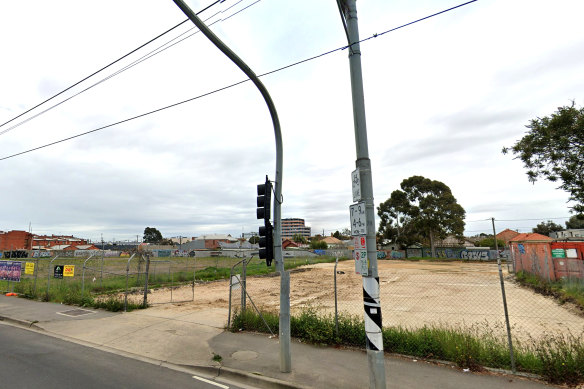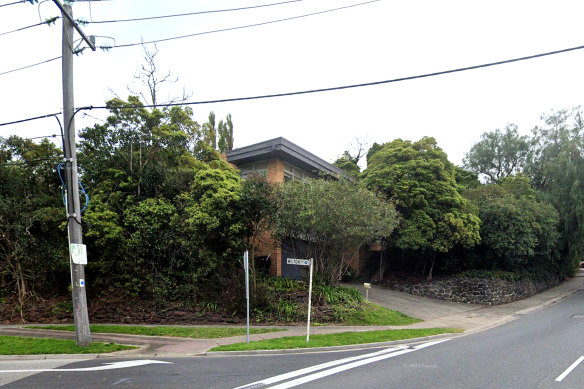This was published 4 months ago
Four Melbourne suburbs targeted in government’s latest housing plan
By Mathew Dunckley and Kieran Rooney
Small blocks of surplus government land will be offered to the private sector for development along with a special financial incentive, under a new trial program to drive the delivery of new homes in existing suburbs.
The announcement of the Small Sites Pilot, which aims to deliver 260 homes across four sites, comes as new figures show councils are more likely to approve very large or very small projects rather than medium density developments.

This site at 541 Sydney Road, Coburg is slated for redevelopment.Credit: Internet
The government will seek expressions of interest from the private sector to develop the sites in Preston, Coburg, Alphington, and Malvern with bidders required to set aside 10 per cent of their proposed projects as affordable housing.
The move comes as permit data, compiled by pro-housing advocacy group YIMBY Melbourne, shows Melbourne councils are more likely to approve tall buildings and single houses than medium-density projects that could be crucial to addressing the housing crisis.
Using publicly available government figures, the group has assessed planning applications, between 2015 and 2022, across metropolitan Melbourne to determine which areas had the highest rate of permit approvals and the types of homes most likely to be green-lit.
Government briefing material on its pilot program said it would look for developers with experience in delivering medium-density apartment and townhouse developments.

This Toorak Road, Malvern site is targeted for redevelopment.Credit: Internet
“The successful developers will determine the type of housing offered at each site, which may include townhouses and low to mid-rise apartments,” the material said.
As an incentive, the government would allow the settlement of the land sale to be delayed until after construction was completed, allowing the successful developers to move more quickly.
The government said the sites were among 45 surplus government properties that were being rezoned and taken to the market across the state to deliver around 9000 homes.
Expressions of interest for the small site process will close on August 27.
The sites earmarked in the pilot are:
- 18a Miller Street, Preston, where the government predicts approximately 140 homes could be built on vacant land owned by Department of Health;
- 541 Sydney Road, Coburg, where the government predicts 60 homes could be built on vacant land owned by Development Victoria;
- The former rail spur on Grange Road, Alphington, where the government predicts 50 homes could be built on land owned by VicTrack; and
- 734 and 736 Toorak Road, Malvern, where the government predicts 10 homes could be built on land owned by the Department of Transport and Planning.
“There is nothing more important than a roof over your head and this is about sending a clear signal to the private sector and giving them more certainty,” said Minister for Development Victoria Colin Brooks.
Brooks said the policy would help the government meet its target of building 800,000 homes over the next decade.
The government has struggled to achieve progress towards this goal, a fact emphasised by Opposition Leader John Pesutto on the weekend where he noted that the number of dwellings approved had gone backwards since the government unveiled its housing statement.
Pesutto announced a policy to tighten cultural heritage and Melbourne Water approval processes to speed up housing delivery if he won the next election. The policy drew fire from Indigenous leaders who labelled it a dog-whistle to racist voters.
On Monday, Pesutto defended the opposition’s policy saying it had been formulated in the usual way and dismissed allegations it was race-baiting as “nonsense”.
Pesutto said Indigenous leaders were “well aware” of the opposition’s position on the “straightforward reforms”.
The YIMBY Melbourne figures, which showed the type of dwellings most likely to be approved, were collected partly to test an analysis by the Municipal Association of Victoria in this masthead which said more than 98 per cent of housing permits were granted by professional planning officers at councils.
YIMBY leader Jonathan O’Brien said the group’s data refuted MAV’s findings and showed that approval rates were lowest for “missing middle” projects that deliver between six and 50 new homes.
Projects with between 11 and 20 dwellings had the lowest approval rate from councils (56.86 per cent) while 17.56 per cent of rejected projects in this category went on to receive permits later after going to VCAT.
About 84.5 per cent of single homes are approved at the council process while three quarters of projects with more than 200 dwellings were ticked off.
“Our analysis suggests that our current planning system is likely a large contributing factor to why Melbourne’s middle is missing in the first place. Our system is geared toward approving tall towers or endless sprawl—and very little in between,” O’Brien said.
The data showed Brimbank had the highest approval rates of any council, 90 per cent, compared to just 37.8 per cent of projects in Banyule, the lowest in Melbourne. The average across the city was 74 per cent.
Banyule Mayor Tom Melican said the council was committed to increasing housing density.
“We also appreciate and support Melbourne’s need to increase the density of our established urban areas – instead of just growing outwards,” he said.
He said Banyule approved 85.5 per cent of planning applications related to residential development for single and multi-dwelling applications, featuring between two and 10 dwellings in the last financial year.
A government spokesperson said it had a team working with councils to clear application backlogs. It is also in the process of setting growth targets for councils.
MAV president David Clark said that process would encourage the development of a range of new housing options.
“It is clear that increasing housing supply is about more than just planning permits – which continue to be decided upon by councils at pace across the state,” he said.